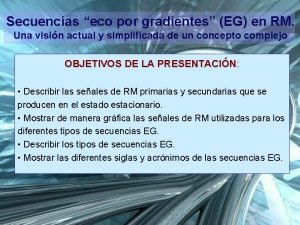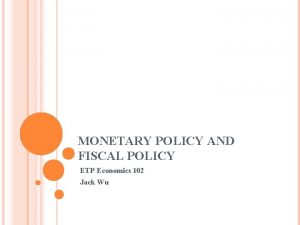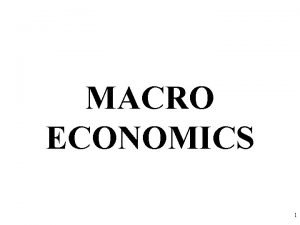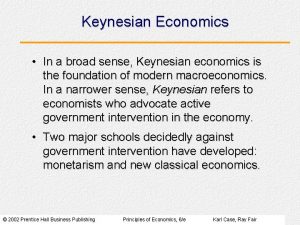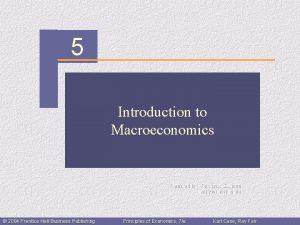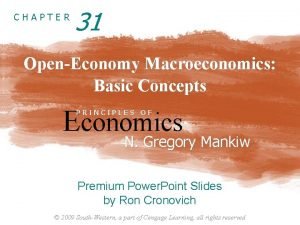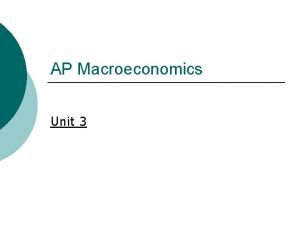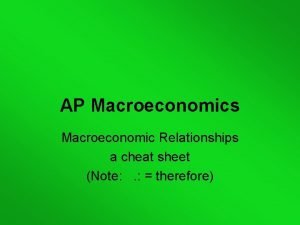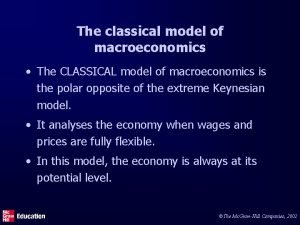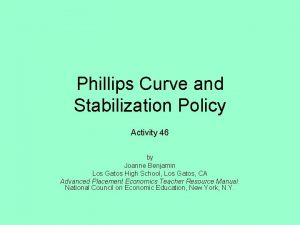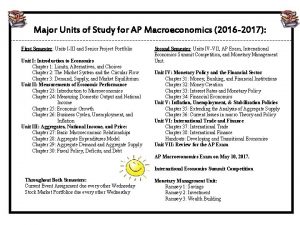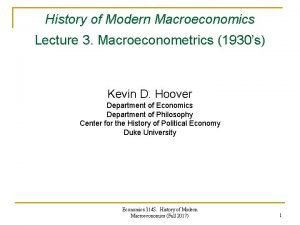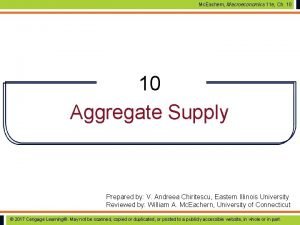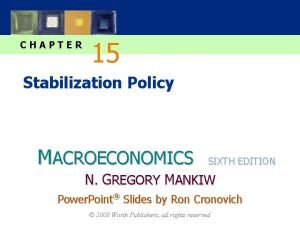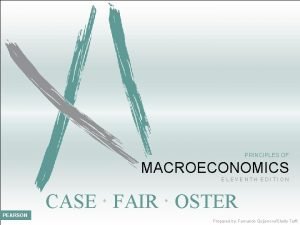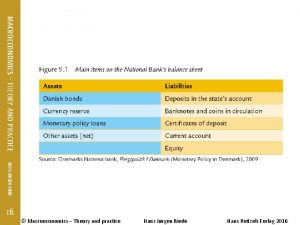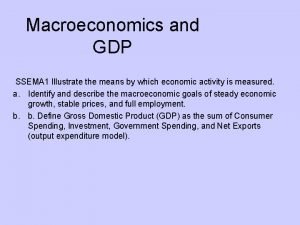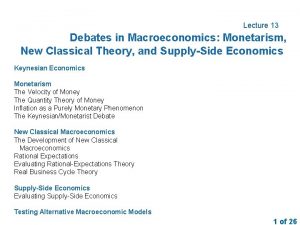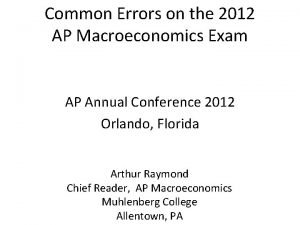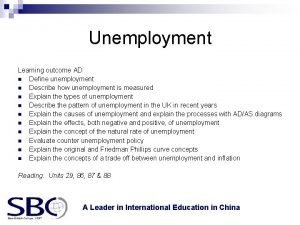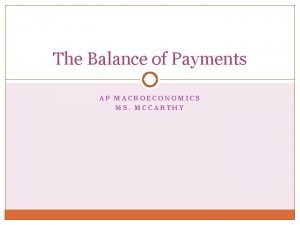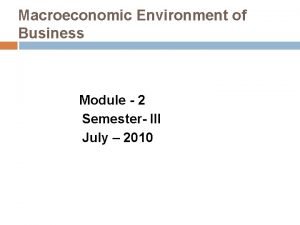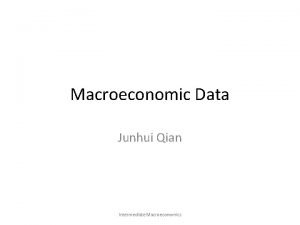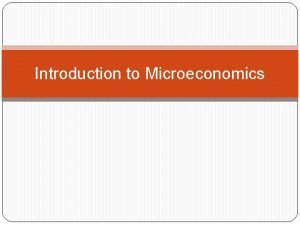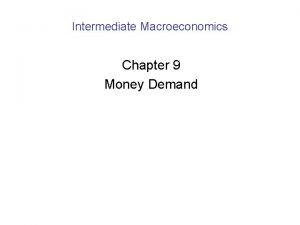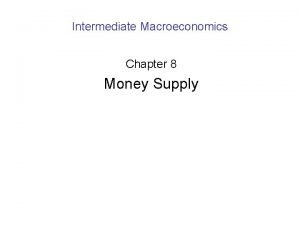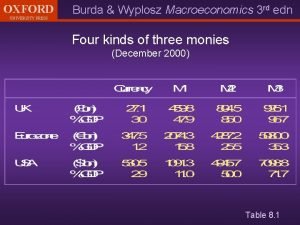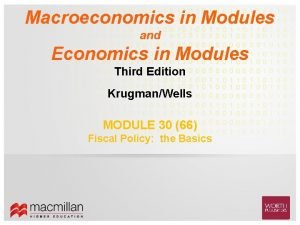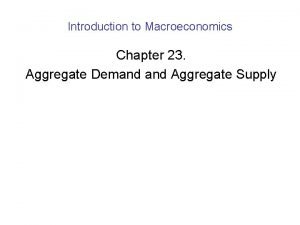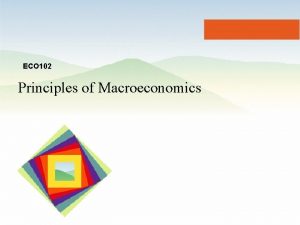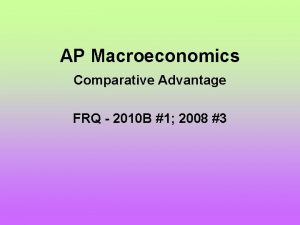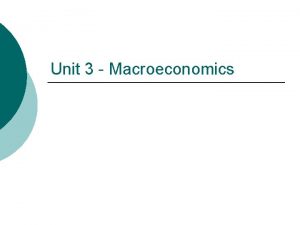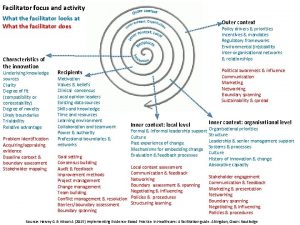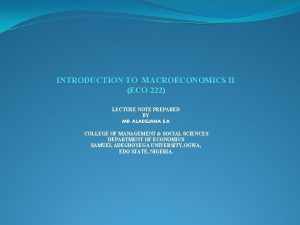Introduction To Macroeconomics Eco 1201 FACILITATOR MUHEREZA FRANKLIN












































































- Slides: 76

Introduction To Macroeconomics Eco 1201 FACILITATOR: MUHEREZA FRANKLIN CONTACT: 0777094955 EMAIL: muherezaf@yahoo. com

PROGRAMMES • BEC, BEAS, BSTAT, BBA, BBC, BHR, BSP, BIB, BPA, BDS, BSW, BMC, BGC, BIC, BAE, BSE & BSEM

INTRODUCTION • The term Macro comes from agreek word “ Makros” which means big or large when translated into English.

CONT…. • Macroeconomics is a branch of economics that studies the behavior, structure, performance and decision making of the entire economy.

Introduction continued § Therefore macroeconomics studies the economy as a whole. Macroeconomics seeks to identify and address the macroeconomic imbalances i. e.

CONT… • Unemployment, Inflation, Balance of payment deficit and Slow economic growth.

IMPORTANCE OF MACROECONOMICS v. Macroeconomics is used for policy analysis v. Evaluation of the overall performance of the economy

CONT… v. Macroeconomics is useful in the formulation of economic policies v. Gives a bird eye view of the global economy

NATIONAL INCOME v. This is the measure of total monetary value of all final goods and services produced by nationals of a given country during the specific period of time, usually in a period of one year.

DIFFERENT CONCEPTS OF NATIONAL INCOME v. Gross Domestic Product. This is the money value of goods and services produced within the domestic territories of a country excluding net factor incomes from a broad.

CONT… v. Gross National Product. The monetary value of goods and services produced by nationals country. living within and outside the

CONT… v. Net National Product. This is the money value of total production after allowance has been made for depreciation of capital goods used in the production process.

CONT… v. Nominal Gross National Product. This is the monetary value of all final goods and services based on current market prices in a given period of time without deduction of capital depreciation.

CONT… • Net National Product at factor cost. This is the sum of wages, rent, profits and interest paid to factors of production for their contribution in the production process.

CONT… v. Disposable Income. This is the income that individuals remain with after deduction of taxes i. e. yd = C+S

CONT… v. Real Gross National Product. This is the national output valued at the prices prevailed during the base year or previous year.

CONT… • Personal Income. This is the total Income of a household in a given financial year.

METHODS/ APPROACHES OF MEASURING NATIONAL INCOME • Income Method. This is when all net factor Incomes earned by factors of production such as Rent, Interest, Wages and profits are summed up during the accounting year.

CONT… • Expenditure Method. This includes summing up all expenditures of households and government on final goods and services during the accounting year i. e. GDP = C+I+G+(X-M).

Methods continued • Output Method/ Value added. This involves adding up of total contributions made by various sectors of the economy.

CONT… • Therefore it involves the summing up of all the money value of final goods and services produced by different sectors in the economy.

DIFFICULTIES IN MEASURING NATIONAL INCOME v. Non monetary transactions The first problem in National Income accounting relates to the treatment of non-monetary transactions such as the services of housewives to members of the families.

CONT… • For example, if a man employees a maid servant for household work, payment to her will appear as a positive item in the national income.

CONT… • But if the man were to marry the maid servant, she would be performing the same job as before but without any extra payments. In this case, the national income will decrease as her services performed remains the same as before.

CONT… v. Problem of double counting. Only final goods and services should be included in the national income accounting. But, it is very difficult to distinguish between final goods and intermediate goods and services .

CONT… • For example, intermediate goods and services used for final consumption. The difference between final goods, services and intermediate goods and services depends on the use of those goods and services so there are possibilities of double counting.

Difficulties continued v. The Underground Economy. The underground economy consists of illegal and un cleared transactions where the goods and services are themselves illegal such as drugs, gambling, smuggling, and prostitution.

CONT… • Since, these incomes are not included in the national income, the national income seems to be less than the actual amount as they are not included in National income.

CONT… v. Petty Production. There are large numbers of petty producers and it is difficult to include their production in national income because they do not maintain any account or transaction records.

CONT… v. Public services. Another problem is whether the public services like general administration, police, army services, should be included in national income or not. It is very difficult to evaluate such services.

CONT… v. Transfer payments. Individuals get pension, unemployment allowance and interest on public loans, but these payments create difficulty in the measurement of national income since they are not considered.

CONT… • These earnings are part of individual’s income and they are also part of government expenditures.

CONT… v. Capital Gains or Loss. When the market prices of capital assets change the owners make capital gains or loss such gains or losses are not included in national income.

CONT… v. Price changes. National income is the money value of goods and services. Money value depends on market price, which often changes. The problem of changing prices is one of the major problems of national income accounting.

CONT… • Due to price rises the value of national income for particular year tends to increase even when the production is decreasing.

CONT… v. Wages and salaries paid in kind Additional payments made in kind may not be included in national income.

CONT… • But the facilities given in kind are calculated as the supplements of wages and salaries on the income side.

CONT… v. Illiteracy and Ignorance. The main problem is whether to include the income generated within the country or even generated abroad in national income and which method should be used in the measurement of national income.

Factors affecting the size of National Income • Level of natural resources and their level of exploitation • Human resources • Capital resources

CONT… • Level of determination to Self sufficiency • Political climate • Level of investment • Level of infrastructure development

Uses of National Income figures • National policy analysis; Policies on employment can be based on the level of output, investment etc. Also policies on inflation, taxation can be based on national income statistics.

CONT… • For comparison purposes; They are used for international comparison to see the status of the economy at that particular time.

CONT… • Determination of per capita income; They are used for measuring per capita income, which is a good indicator of either an improvement or a decline in the standard of living.

CONT… • Helps to show the distribution of income among the various sectors of the economy.

Weaknesses of using National Income Figures as a measure of S. O. L v. It does not consider the type of goods produced. Some goods may not have direct welfare improvement Production of fire arms. e. g.

CONT… v. Expenditure figures may be magnified in countries where there are wars; pollution and this may not necessarily improve the welfare of the people.

Weaknesses continued • The national income statistics do not include the income distribution pattern since it is just an average.

THE FOUR MAJOR SECTORS OF THE ECONOMY • Consumer or House hold sector(C); The role of the house hold sector includes the supply of labor services to other factors of production and also the payment of taxes to the Government for the provision of social goods and services.

CONT… • Business Sector (I); This includes all production units and aims at profit maximization. The role of the business sector includes the provision of goods and services and payment of taxes to the Government.

Major sectors continued • Government Sector (G); In economics, Government is treated as an economic agent and its role include; taxation, employment creation, maintaining law and order etc.

CONT…. • Otherwise known as its distribution function include; provision of goods and services especially those that cannot be provided by the private sector such as National defense, schools, police, roads and this is known as the allocation function.

Major sectors continued • External or Foreign Sector(X-M); This comes in through international trade and international capital flow. It includes both exports and imports. In this sector we analyze what determines the gap between exports and imports.

THE BASIC/ SIMPLEKEYNESIAN MODEL • The simple Keynesian model states that output is determined by the level of aggregate demand which is contrary to say’s law of market which states that “supply creates its own demand. ”

CONT…. • Keynes emphasized that it is aggregate demand which brings changes in the equilibrium employment. level of income and

CONT… • Aggregate demand comes out of total spending i. e. household spending, private business spending (investment) and government expenditure on goods and services and Net exports in a closed economy. i. e. AD = C+I+G + (X-M)

COMPONENTS OF AGGREGATE DEMAND • Consumption is the largest component of aggregate demand. It constitutes over 62% of the GNP of the economy. Consumption refers to the expenditure of households (consumers) on final good and services.

THE CONSUMPTION FUNCTION • This is a mathematical relationship showing the rate of desired consumer expenditures at various levels of income. That is, it shows the relationship between consumption expenditures and the current disposable income.

CONT… • It shows that consumption is an increasing function of disposable income. In brief, consumption function provides a precise basis for predicting how changes in disposable income will affect consumption (c).

Two Components of Consumption • Autonomous consumption (a). This kind of consumption does not depend on the level of current income; Shows the amount of consumption expenditure at zero (0) level of current disposable income.

CONT… • This expenditure comes out of the past savings or non-income influences, borrowings or purchasing goods and services on credit.

Components of Consumption continued • Income induced consumption. This kind of consumption is determined by the level of current disposable income. That is, it increases when disposable income increases and vice versa.

CONT… • Therefore total consumption equals to autonomous consumption plus income induced consumption. i. e. C = a+byd

NON INCOME DETERMINANTS OF CONSUMPTION • Consumers’ expectations • Taxes • Credit

CONT…. • Government subsidies • The rate of interest • Existing stock of durable goods

PROPENSITIES TO CONSUME • Keynes identified two different ways of describing the consumption and income relationship and these include;

CONT… v. Average propensity to consume (APC) This refers to the proportion of total disposable income that is spent by households on the consumption of final goods and services.

CONT… It is computed by dividing the total consumption in a given period by the related total disposable income. APC = C yd

Propensities continued • Marginal Propensity to Consume. This is the second measure of consumption behavior. It refers to the proportion of additional income which is spent on consumption.

SAVINGS • Savings refer to the proportion of current disposable income that is not spent on consumption i. e. it is any income that is left over after consumption expenditures.

CONT… • Thus yd = c + s, yd – c = s where s = savings, c = consumption, yd = disposable income.

Saving Function • This shows the relationship between savings and the current disposable income. At low levels of disposable income (yd) households consume more than their current income.

Propensities To Save • Average Propensity to Save (Avs). This is a proportion of disposable income (yd) that is saved. • Marginal Propensity to Save (MPS). This is the proportion of additional income that is not consumed

Reasons For Saving • To keep reserves for unforeseen situations such as sickness, famine, wars among others. • Preserve for the old age • Saving can also be a habit

CONT… • To enjoy and increase future income • To derive satisfaction out of money i. e. misers • Desire for power and wealth

Determinants of Savings • Level of income • Interest rates • Level of development of financial institutions • Inflation rate

CONT… • level of education and the cultural set up • Dependence ratio • Political climate • Government policy
 Eco gradiente resonancia magnetica
Eco gradiente resonancia magnetica 1201 broad rock blvd
1201 broad rock blvd English 1201
English 1201 After their escape jonas transmit memories
After their escape jonas transmit memories Skilled trades 1201
Skilled trades 1201 The blue helmet characters
The blue helmet characters Introduction of eco club
Introduction of eco club Branches of economics
Branches of economics Macroeconomics
Macroeconomics Crowding out effect macroeconomics
Crowding out effect macroeconomics Crowding out effect macroeconomics
Crowding out effect macroeconomics Graphing monetary and fiscal policy interactions
Graphing monetary and fiscal policy interactions Definition managerial economics
Definition managerial economics Cyclical unemployment diagram
Cyclical unemployment diagram Micro economics
Micro economics Nominal gdp formula
Nominal gdp formula New classical macroeconomics
New classical macroeconomics New classical macroeconomics
New classical macroeconomics Crowding out effect macroeconomics
Crowding out effect macroeconomics 2012 macroeconomics frq
2012 macroeconomics frq Expanded circular flow diagram
Expanded circular flow diagram Ap macroeconomics-percentage for a 5
Ap macroeconomics-percentage for a 5 Chapter 31 open economy macroeconomics
Chapter 31 open economy macroeconomics Macroeconomics deals with:
Macroeconomics deals with: New classical macroeconomics
New classical macroeconomics New classical and new keynesian macroeconomics
New classical and new keynesian macroeconomics Ap macroeconomics unit 3
Ap macroeconomics unit 3 Macroeconomics cheat sheet
Macroeconomics cheat sheet Ap macro graphs
Ap macro graphs Macroeconomics
Macroeconomics Macroeconomics lesson 3 activity 46
Macroeconomics lesson 3 activity 46 Components of macroeconomics
Components of macroeconomics Economics michael parkin 13th edition
Economics michael parkin 13th edition Macroeconomics mankiw 9th edition
Macroeconomics mankiw 9th edition Ap macroeconomics frq 2016
Ap macroeconomics frq 2016 Macroeconomics chapter 7
Macroeconomics chapter 7 Macroeconometrics
Macroeconometrics Growth rate nominal gdp formula
Growth rate nominal gdp formula Macroeconomics chapter 8
Macroeconomics chapter 8 Macroeconomics
Macroeconomics Macroeconomics
Macroeconomics What is macroeconomics
What is macroeconomics Site:slidetodoc.com
Site:slidetodoc.com Macroeconomics
Macroeconomics Macroeconomics
Macroeconomics Ap macroeconomics supply and demand analysis
Ap macroeconomics supply and demand analysis Macroeconomics
Macroeconomics Circuitist definition
Circuitist definition Principles of macroeconomics case fair oster
Principles of macroeconomics case fair oster Macroeconomics theory and practice
Macroeconomics theory and practice Macroeconomics
Macroeconomics Macroeconomics definition economics
Macroeconomics definition economics What is included in gdp
What is included in gdp Monetarist vs classical economics
Monetarist vs classical economics Intermediate macroeconomics mankiw
Intermediate macroeconomics mankiw Macroeconomics
Macroeconomics 2012 ap macroeconomics free response answers
2012 ap macroeconomics free response answers Macroeconomics
Macroeconomics Rules vs discretion macroeconomics
Rules vs discretion macroeconomics Unemployment
Unemployment Fiscal policy definition
Fiscal policy definition Ap macroeconomics balance of payments
Ap macroeconomics balance of payments Open market operations
Open market operations Macroeconomics
Macroeconomics Limitations of macroeconomics
Limitations of macroeconomics Junhui qian
Junhui qian Uses of microeconomics
Uses of microeconomics Macroeconomics
Macroeconomics Macroeconomics
Macroeconomics New classical and new keynesian macroeconomics
New classical and new keynesian macroeconomics Tourism macroeconomics
Tourism macroeconomics Burda macroeconomics
Burda macroeconomics Macroeconomics in modules
Macroeconomics in modules Macroeconomics chapter 23
Macroeconomics chapter 23 Macroeconomics
Macroeconomics Comparative advantage frq
Comparative advantage frq Unwrap core standard
Unwrap core standard
